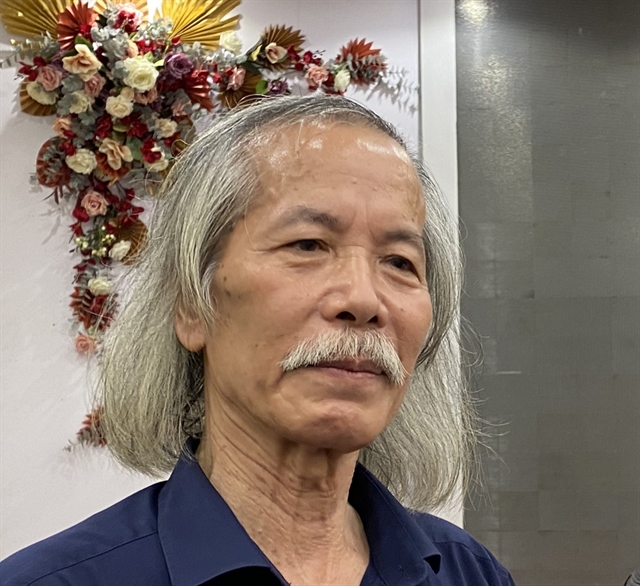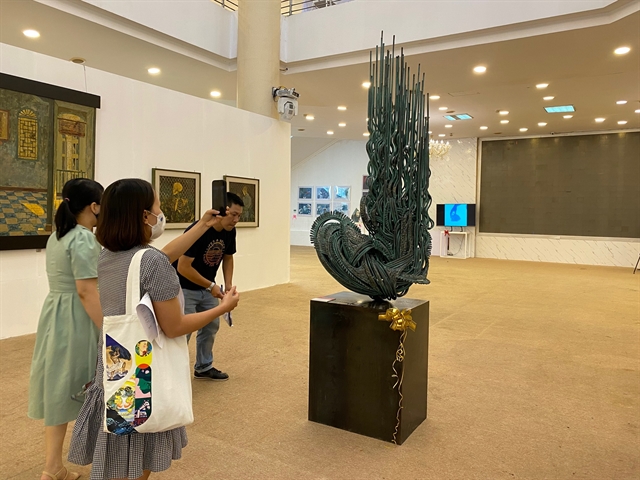 Life & Style
Life & Style

Lê Hương speaks with painter Lương Xuân Đoàn, chairman of the Việt Nam Fine Arts Association, about the ongoing Young Fine Arts Festival and Việt Nam’s fine art scene.
 |
| Painter Lương Xuân Đoàn. — VNS Photo Lê Hương |
What do you think about the works at the Young Fine Arts Festival?
Young artists have made considerable contributions using various materials, from traditional lacquer to graphics or sculpture.
We recognise the active contributions of young artists to the success of the 6th Young Fine Arts Festival. The best works have been very carefully considered by the art council. Social issues have been reflected in all works at the festival.
What do you think about young artists and their creations?
Many young artists seem to be very old now. They are just repeating old stories, what they are thinking and doing. They seem to have not found a way to escape and tell a different story or express a fresh point of view, a different way of thinking.
They seem to be very cautious. They do not dare to express their thinking today, just rely on yesterday’s thinking to be safely chosen for the exhibition. I sympathise with them. They have the right to think twice about what topic they should tell in contemporary society. But the art council expected them to break old orders, to even challenge the council. That’s the best condition to have a panorama of Vietnamese fine arts.
That’s why only 126 works by 102 artists have been chosen to be displayed at the exhibition out of 512 entries by 216 artists.
There are many creative young artists who have not joined the festival.
You said that many good artists have not joined the festival. Do you think that the festival is not attractive enough? Should you change the way it is organised?
The organisers do not and cannot force all young artists to join the festival. This is one of the playgrounds following the Central Party’s Resolution 05/1987, which highly respects freedom in creation.
The artists have the right to join or not. They have no pressure to join in.
I think the biennial national festival is just an official playground, where young artists raise different voices.
We should not put any pressure on young artists.
I have been wondering why in the 1990s, there were many artists expressing themselves very differently in performances or installations. Though they have received strong reactions from the public and critics, they still created artworks.
This time we chose only two video artworks including a second prize for a video artwork telling a story about the environment.
I remember I was stunned at a performance by an artist, who broke a loaf of bread and dipped it in a jar full of eels covered with bubbles of water. The artist then enjoyed each piece of bread slowly. That's a shocking performance, I think.
But in this prize-winning video, a man and a woman slowly ate a plastic bag. They then take out eggs from their mouth. They portray a message on environment and Iife.
I see that their thinking is no longer the same as young artists of the past. We have not been able to understand the youth and share difficulties with them. We do not know what they need. The fine arts association agreed to let them raise their voices. But whether their voices are heard today, that’s another problem.
I think what is displayed here has somewhat reflected the story of contemporary fine arts. Where are the arts now? Where are they heading? What do they expect from the destination? Those questions are not easy to answer. Even to young artists themselves.
 |
| Viewers look at the fist-prize-winning sculpture titled Upstream Flood 2 by Trần Đình Thắng. — VNS Photo Lê Hương |
What’s the most pressing problem in fine arts?
I think today's society puts too much pressure on young artists. We should not press them, let them be free to choose their ways. I think today’s management thinking is pressing on young artists. The authorities can shut down this exhibition, and not grant permission to others. The young artists must have been discouraged by that.
We haven’t got a law on the freedom to practise arts. If we have that law, young students, who are studying, have no job, or do not join any career association can publish their works. Then they can have the courage to speak out.
I think most young artists are still full of patriotism and devoted to the country. They inherit old values and property handed down by their parents. Their most important challenge is what they should do when they inherit such a heritage. They should raise fresh voices rather than the same voices as the previous generations. — VNS




